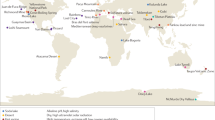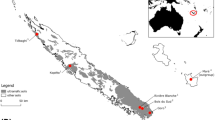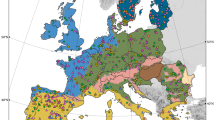Abstract
Productivity is a major determinant of ecosystem diversity. Microbial ecosystems are the most diverse on the planet yet very few relationships between diversity and productivity have been reported as compared with macro-ecological studies. Here we evaluated the spatial relationships of productivity and microbiome diversity in a laboratory-cultivated photosynthetic mat. The goal was to determine how spatial diversification of microorganisms drives localized carbon and energy acquisition rates. We measured sub-millimeter depth profiles of net primary productivity and gross oxygenic photosynthesis in the context of the localized microenvironment and community structure, and observed negative correlations between species richness and productivity within the energy-replete, photic zone. Variations between localized community structures were associated with distinct taxa as well as environmental profiles describing a continuum of biological niches. Spatial regions in the photic zone corresponding to high primary productivity and photosynthesis rates had relatively low-species richness and high evenness. Hence, this system exhibited negative species–productivity and species–energy relationships. These negative relationships may be indicative of stratified, light-driven microbial ecosystems that are able to be the most productive with a relatively smaller, even distributions of species that specialize within photic zones.
Similar content being viewed by others
Log in or create a free account to read this content
Gain free access to this article, as well as selected content from this journal and more on nature.com
or
References
Anderson G . (1958). Some limnological features of a shallow saline meromictic lake. Limnol Oceanogra 3: 259–270.
Anderson MJ, Willis TJ . (2003). Canonical analysis of principal coordinates: a useful method of constrained ordination for ecology. Ecology 84: 511–525.
Bernstein HC, Kesaano M, Moll K, Smith T, Gerlach R, Carlson RP et al. (2014). Direct measurement and characterization of active photosynthesis zones inside wastewater remediating and biofuel producing microalgal biofilms. BioresTechnol 156: 206–215.
Bienhold C, Boetius A, Ramette A . (2012). The energy–diversity relationship of complex bacterial communities in Arctic deep-sea sediments. ISME J 6: 724–732.
Canfield DE, Des Marais DJ . (1993). Biogeochemical cycles of carbon, sulfur, and free oxygen in a microbial mat. Geochim Cosmochim Acta 57: 3971–3984.
Caporaso JG, Kuczynski J, Stombaugh J, Bittinger K, Bushman FD, Costello EK et al. (2010). QIIME allows analysis of high-throughput community sequencing data. Nat Methods 7: 335–336.
Chase JM, Leibold MA . (2002). Spatial scale dictates the productivity–biodiversity relationship. Nature 416: 427–430.
Cole JK, Hutchison JR, Renslow RS, Kim Y-M, Chrisler WB, Engelmann HE et al. (2014). Phototrophic biofilm assembly in microbial-mat-derived unicyanobacterial consortia: model systems for the study of autotroph-heterotroph interactions. Front Microbiol 5: 109.
DeLong JP . (2008). The maximum power principle predicts the outcomes of two‐species competition experiments. Oikos 117: 1329–1336.
Edgar RC . (2010). Search and clustering orders of magnitude faster than BLAST. Bioinformatics 26: 2460–2461.
Edgar RC, Haas BJ, Clemente JC, Quince C, Knight R . (2011). UCHIME improves sensitivity and speed of chimera detection. Bioinformatics 27: 2194–2200.
Field CB, Behrenfeld MJ, Randerson JT, Falkowski P . (1998). Primary production of the biosphere: integrating terrestrial and oceanic components. Science 281: 237–240.
Glud RN, Ramsing NB, Revsbech NP . (1992). Photosynthesis and photosynthesis‐coupled respiration in natural biofilms quantified with oxygen microsensors. J Phycol 28: 51–60.
Grace JB, Anderson TM, Seabloom EW, Borer ET, Adler PB, Harpole WS et al. (2016). Integrative modelling reveals mechanisms linking productivity and plant species richness. Nature 529: 390–393.
Ha PT, Renslow RS, Atci E, Reardon PN, Lindemann SR, Fredrickson JK et al. (2015). Regulation of electron transfer processes affects phototrophic mat structure and activity. Front Microbiol 6: 909.
Hamady M, Lozupone C, Knight R . (2010). Fast UniFrac: facilitating high-throughput phylogenetic analyses of microbial communities including analysis of pyrosequencing and PhyloChip data. ISME J 4: 17–27.
Harris JK, Caporaso JG, Walker JJ, Spear JR, Gold NJ, Robertson CE et al. (2013). Phylogenetic stratigraphy in the Guerrero Negro hypersaline microbial mat. ISME J 7: 50–60.
Hurlbert AH . (2006). Linking species–area and species–energy relationships in Drosophila microcosms. Ecol Lett 9: 287–294.
Hurlbert AH, Stegen JC . (2014). When should species richness be energy limited, and how would we know? Ecol Lett 17: 401–413.
Jensen SI, Steunou A-S, Bhaya D, Kühl M, Grossman AR . (2011). In situ dynamics of O2, pH and cyanobacterial transcripts associated with CCM, photosynthesis and detoxification of ROS. ISME J 5: 317–328.
Jørgensen BB, Revsbech NP, Blackburn TH, Cohen Y . (1979). Diurnal cycle of oxygen and sulfide microgradients and microbial photosynthesis in a cyanobacterial mat sediment. Appl Environ Microb 38: 46–58.
Kühl M, Glud RN, Ploug H, Ramsing NB . (1996). Microenvironmental control of photosynthesis and photosynthesis‐coupled respiration in an epilithic cyanobacterial biofilm. J Phycol 32: 799–812.
Lassen C, Ploug H, Jørgensen BB . (1992). A fibre-optic scalar irradiance microsensor: application for spectral light measurements in sediments. FEMS Microbiol Lett 86: 247–254.
Lauro FM, DeMaere MZ, Yau S, Brown MV, Ng C, Wilkins D et al. (2011). An integrative study of a meromictic lake ecosystem in Antarctica. ISME J 5: 879–895.
Ley RE, Harris JK, Wilcox J, Spear JR, Miller SR, Bebout BM et al. (2006). Unexpected diversity and complexity of the Guerrero Negro hypersaline microbial mat. Appl Environmental Microb 72: 3685–3695.
Lindemann SR, Moran JJ, Stegen JC, Renslow RS, Hutchison JR, Cole JK et al. (2013). The epsomitic phototrophic microbial mat of Hot Lake, Washington: community structural responses to seasonal cycling. Front Microbiol 4: 323.
Lone AG, Atci E, Renslow R, Beyenal H, Noh S, Fransson B et al. (2015a). Colonization of epidermal tissue by Staphylococcus aureus produces localized hypoxia and stimulates secretion of antioxidant and caspase-14 proteins. Infect Immun 83: 3026–3034.
Lone AG, Atci E, Renslow R, Beyenal H, Noh S, Fransson B et al. (2015b). Staphylococcus aureus induces hypoxia and cellular damage in porcine dermal explants. Infect Immun 83: 2531–2541.
Lotka AJ . (1922). Contribution to the energetics of evolution. Proc Natl Acad Sci USA 8: 147–151.
Lozupone C, Knight R . (2005). UniFrac: a new phylogenetic method for comparing microbial communities. Appl Environ Microb 71: 8228–8235.
May RM . (1975). Patterns of species abundance and diversity. Ecol Evol Commun. Harvard University Press:: Cambridge, MA, USA, pp 81–120.
McDonald D, Price MN, Goodrich J, Nawrocki EP, DeSantis TZ, Probst A et al. (2012). An improved Greengenes taxonomy with explicit ranks for ecological and evolutionary analyses of bacteria and archaea. ISME J 6: 610–618.
McMurdie PJ, Holmes S . (2013). phyloseq: an R package for reproducible interactive analysis and graphics of microbiome census data. PLoS One 8: e61217.
Moran JJ, Newburn MK, Alexander ML, Sams RL, Kelly JF, Kreuzer HW . (2011). Laser ablation isotope ratio mass spectrometry for enhanced sensitivity and spatial resolution in stable isotope analysis. Rapid Commun Mass Spectrom 25: 1282–1290.
Moran JJ, Doll CG, Bernstein HC, Renslow RS, Cory AB, Hutchison JR et al. (2014). Spatially tracking 13C‐labelled substrate (bicarbonate) accumulation in microbial communities using laser ablation isotope ratio mass spectrometry. Environ Microbiol Rep 6: 786–791.
Narihiro T, Kamagata Y . (2013). Cultivating yet-to-be cultivated microbes: the challenge continues. Microbes Environ 28: 163–165.
Nelson WC, Maezato Y, Wu Y-W, Romine MF, Lindemann SR . (2016). Identification and resolution of microdiversity through metagenomic sequencing of parallel consortia. Appl Environ Microb 82: 255–267.
Odum HT, Pinkerton RC . (1955). Time’s speed regulator: the optimum efficiency for maximum power output in physical and biological systems. Am Sci 43: 331–343.
Oksanen J, Kindt R, Legendre P, O’Hara B, Stevens MHH, Oksanen MJ et al. (2007). The vegan package. Community ecology package. 10. Available at: https://cran.r-project.org/web/packages/vegan/.
Price MN, Dehal PS, Arkin AP . (2010). FastTree 2–approximately maximum-likelihood trees for large alignments. PLoS One 5: e9490.
Prosser JI, Bohannan BJ, Curtis TP, Ellis RJ, Firestone MK, Freckleton RP et al. (2007). The role of ecological theory in microbial ecology. Nat Rev Microbiol 5: 384–392.
Rajaniemi TK . (2003). Explaining productivity‐diversity relationships in plants. Oikos 101: 449–457.
Renslow RS, Babauta JT, Dohnalkova A, Boyanov MI, Kemner KM, Majors PD et al. (2013). Metabolic spatial variability in electrode-respiring Geobacter sulfurreducens biofilms. Energy Environ Sci 6: 1827–1836.
Risatti J, Capman W, Stahl D . (1994). Community structure of a microbial mat: the phylogenetic dimension. Proc Natl Acad Sci USA 91: 10173–10177.
Rognes T, Mahé F, Flouri T, McDonald D, Schloss P, Woodcroft BJ . (2016). VSEARCH: a versatile open source tool for metagenomics. PeerJ Preprints 6: e2409v1. Available at: https://doi.org/10.7287/peerj.preprints.2409v1.
Srivastava DS, Lawton JH . (1998). Why more productive sites have more species: an experimental test of theory using tree‐hole communities. Am Nat 152: 510–529.
Turner JR, Lennon JJ, Lawrenson JA . (1988). British bird species distributions and the energy theory. Nature 335: 539–541.
Wong HL, Smith D-L, Visscher PT, Burns BP . (2015). Niche differentiation of bacterial communities at a millimeter scale in Shark Bay microbial mats. Sci Rep 5: 15607.
Wright DH . (1983). Species-energy theory: an extension of species-area theory. Oikos 41: 496–506.
Wylie JL, Currie DJ . (1993). Species-energy theory and patterns of species richness: I. Patterns of bird, angiosperm, and mammal species richness on islands. Biol Conserv 63: 137–144.
Yamada T, Sekiguchi Y, Hanada S, Imachi H, Ohashi A, Harada H et al. (2006). Anaerolinea thermolimosa sp. nov., Levilinea saccharolytica gen. nov., sp. nov. and Leptolinea tardivitalis gen. nov., sp. nov., novel filamentous anaerobes, and description of the new classes Anaerolineae classis nov. and Caldilineae classis nov. in the bacterial phylum Chloroflexi. Int J Syst Evol Microbiol 56: 1331–1340.
Zachara JM, Moran JJ, Resch CT, Lindemann SR, Felmy AR, Bowden ME et al. (2016). Geo-and biogeochemical processes in a heliothermal hypersaline lake. Geochim Cosmochim Acta 181: 144–163.
Acknowledgements
This research was supported by the US Department of Energy Office of Biological and Environmental Research (BER) Genomic Science Program and is a contribution of the Fundamental Scientific Focus Area. The work conducted by the U.S. DOE Joint Genome Institute was supported by the Office of Science of the U.S. DOE under contract No. DE-AC0205CH11231 and Community Sequencing Project 701. HCB and RSR are grateful for support given by the Linus Pauling Distinguished Postdoctoral Fellowship, a Laboratory Directed Research program at PNNL. We wish to acknowledge William P. Inskeep, William C. Nelson, James C. Stegen and Jennifer M. Mobberley for helpful discussions and critical review of this study. PNNL is operated for the DOE by Battelle Memorial Institute under Contract DE-AC05-76RLO 1830.
Author information
Authors and Affiliations
Corresponding authors
Ethics declarations
Competing interests
The authors declare no conflict of interest.
Additional information
Supplementary Information accompanies this paper on the ISME Journal website
Rights and permissions
About this article
Cite this article
Bernstein, H., Brislawn, C., Renslow, R. et al. Trade-offs between microbiome diversity and productivity in a stratified microbial mat. ISME J 11, 405–414 (2017). https://doi.org/10.1038/ismej.2016.133
Received:
Revised:
Accepted:
Published:
Issue date:
DOI: https://doi.org/10.1038/ismej.2016.133
This article is cited by
-
Survivability and life support in sealed mini-ecosystems with simulated planetary soils
Scientific Reports (2024)
-
Ecological assessment of groundwater ecosystems disturbed by recharge systems using organic matter quality, biofilm characteristics, and bacterial diversity
Environmental Science and Pollution Research (2020)
-
Forfeiting the priority effect: turnover defines biofilm community succession
The ISME Journal (2019)



